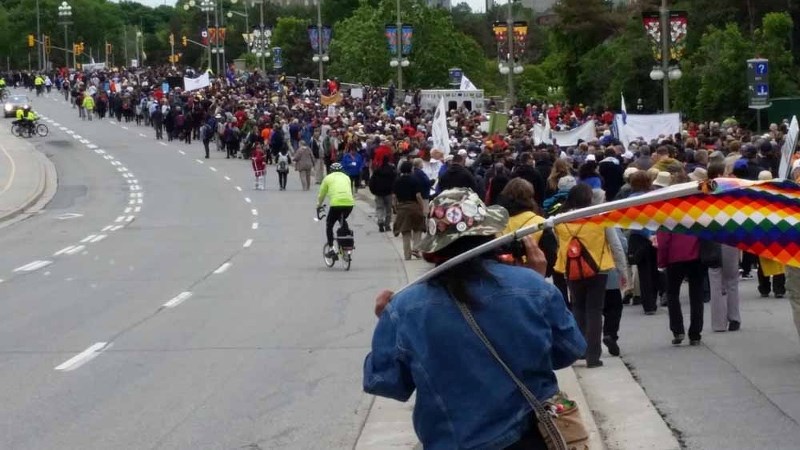Charles Wood remembers when his father and mother first brought him to Blue Quills residential school, his father being threatened with incarceration if he failed to do so.
“I did not know one word of English,” he said, recalling his nine-year-old former self, brought into a world where his language and culture were expressly forbidden. “My first experiences were quite traumatic . . . in my memory, I looked at it as a form of incarceration.”
Children were punished for speaking Cree and for other misdemeanors, with Wood recalling, “I got hit in the head so often it damaged my hearing permanently.”
Wood, along with fellow indigenous people from the area, made his way to Ottawa recently as the Truth and Reconciliation Commission (TRC) wound its way to its ceremonial end. The commission held its closing ceremonies during May 31 to June 3, after six years of hearings and testimony from more than 6,000 residential school survivors and their loved ones.
“We had to be there to show we want to participate,” Wood said of the events held during that week. Flanked by fellow residential school survivors, Eugene Cardinal and Harold Watchmaker from Kehewin Cree Nation, and Saddle Lake Cree Nation’s Eric Large, who worked in the TRC process as a resolution and health support worker, who also attended, Wood explained, “We are concerned and interested in this process.”
Wood said that when the TRC was established, he “was not overly optimistic about any results, positive or otherwise,” given the government’s approach to indigenous people.
However, he noted, “I think the TRC commissioners did a lot of work, good work.”
Some people are ashamed or still suffer from the pain of their past; the TRC commission offered people the chance to publicly or privately share these stories. “I know (for) a lot of them, it was like a load had been taken off their minds, their souls,” said Wood.
At the end, the commission released 94 calls to action, for which Wood, Cardinal, Watchmaker and Large voiced support.
“Upon presentation of the final report, the reception by all parties – with the exception of the (Conservatives) – was very receptive,” said Wood. He recalled that all the people in the room gave Justice Murray Sinclair a standing ovation when he voiced the commission’s support for an inquiry into the high numbers of missing and murdered aboriginal women. However, Bernard Valcourt, the minister of Aboriginal Affairs, remained seated; the Harper government has so far decided not to hold an inquiry into the issue.
“That’s why I stated, I’m not optimistic about Harper and his cronies doing anything (about the recommendations),” said Wood.
Large pointed out that Canada is so far the only United Nations country that has not given full support to the UN’s declaration of Indigenous rights.
However, following the closing ceremonies, Valcourt released a statement on the importance of the event, stating, “Reconciliation is not to forgive and forget, but to remember and change.”
Local MP Brian Storseth said the impact of residential schools was a “horrible” chapter in Canadian history, and hearing the stories of survivors in Ottawa really brought home the impact of that legacy for him.
He said he was glad the Canadian government formed the commission as one of its first acts in office, and said the government will now review the recommendations going forward. As for calls for an inquiry into the status of missing and murdered aboriginal women, he said the government has formed a committee to study the issue, and notes that the minister for the status of women, who sits on the committee, “takes this very seriously.”
Education of people on the history of residential schools was one of the key calls to action in the report for Wood, who said, “In the history books of Canada, there’s very little mention of our people . . . I maintain that it is important the correct and true part of Canadian history is included in the curriculum.”
However, the government should not be the ones compiling and presenting information, since their understanding of history is significantly different from aboriginal people, he said, adding, “We never sold the land – we agreed to share the land.”
Two other recommendations he stressed were the need to look at and address the high representation of aboriginal children in the child welfare system and the high numbers of aboriginals in the justice system. Instead of seeing thousands of aboriginal children in care, he would like to see parents who are having difficulty in their lives being supported, educated and helped to improve their parenting “instead of whisking their children away.”
One other recommendation he made note of was for the Catholic Church to issue an apology for its part in administering residential schools, as the former pope expressed sorrow for the history of residential schools, but stopped short of apologizing for the issues of the past.
Wood said he personally believed the decision to offer compensation in the form of money to survivors was the wrong direction, and the money would have been better spent on education and other funding, while Cardinal said no amount of money can compensate those who have since passed.
“We’re not setting out to point fingers. We are here to suggest a new partnership with all society, so we work together to correct this type of activity and ensure it does never occur again to tarnish the history of this country,” said Wood. “If the recommendations are acted on, there may be hope for us.”



